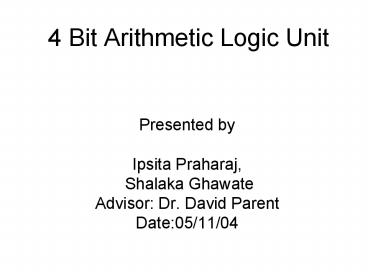4 Bit Arithmetic Logic Unit - PowerPoint PPT Presentation
1 / 29
Title:
4 Bit Arithmetic Logic Unit
Description:
Background. Summary of results. Project Details. Cost Analysis. Conclusions. Abstract ... Create schematics and layouts for adder, AND, OR, MUX, in the cadence tool. ... – PowerPoint PPT presentation
Number of Views:131
Avg rating:3.0/5.0
Title: 4 Bit Arithmetic Logic Unit
1
4 Bit Arithmetic Logic Unit
- Presented by
- Ipsita Praharaj,
- Shalaka Ghawate
- Advisor Dr. David Parent
- Date05/11/04
2
Agenda
- Abstract
- Introduction
- - why
- - Simple Theory
- - Background
- Summary of results
- Project Details
- Cost Analysis
- Conclusions
3
Abstract
- Goal is to design a 4-bit ALU driving upto 30fF
that can perform the following operations - -FULL ADDER
- -AND
- -OR
- -NOR
4
Introduction
- ALU is a building block of several circuits.
- Understanding how an ALU is designed and how it
works is essential to building any advanced logic
circuits. - Using this knowledge and experience, we can move
on to designing more complex integrated circuits. - Design consists of different kind of logicRipple
carry adder, full adder, AND, OR, NOR, DFF, MUX.
5
Block diagram of 4 bit ALU
6
Project Details
- -There are total of 19 pin outs in our design.
- including VDD and GND.
- -There are 9 D flip-flops at the input and 4 at
the output. - -There is a 41 MUX to select the output.
- -Create schematics and layouts for adder, AND,
OR, MUX, in the cadence tool. - -Test the schematic using test bench.
- -Create schematic and layout for 1 bit ALU now
using the schematics for the basic logical units.
- -Test the schematic for 1 bit ALU.
- -Create the single bit ALU to create a 4 bit ALU
layout. - -Run DRC extracted and LVS check to verify the
design.
7
DFF
- DFF are placed on either side of the
combinational logic. - Hold time 0.586n(Fall)
- 0.515n(Rise)
- Setup time0.521n(Fall)
- 0.450n(Rise)
8
Long path calculations
9
Full Adder Schematic
10
Full Adder Layout
11
Full Adder LVS Report
12
2-to-1 MUX schematic
13
4-to-1 MUX layout
14
4-bit ALU schematic
15
4-bit ALU layout
16
4 bit ALU(LVS Report)
17
DFF schematic
18
DFF layout
19
DFF LVS report
20
4 bit ALU with DFF schematic
21
4 bit ALU with DFF layout
22
4 bit ALU with DFF LVS report
23
Transient Analysis
24
Worst case (Tphl)
25
Worst case (Tplh)
26
Post extraction simulation
27
Results
- The ALU performs all 4 functions at a 200Mhz
clock and a load of 30fF. - We meet the power specifications.
- Area of the our layout192micron375micron.
28
Cost Analysis
- Time spent on each phase of the project.
- - Logic design 1 week.
- - Logic check 1 week
- -Individual schematic 5 days
- - Integration of schematic blocks 1 week
- - Layouts 2 weeks
- - Post extraction check 2 days
29
Acknowledgements
- Thanks to Cadence Design systems for the VLSI
labs - Thanks to Professor David Parent for his guidance.

